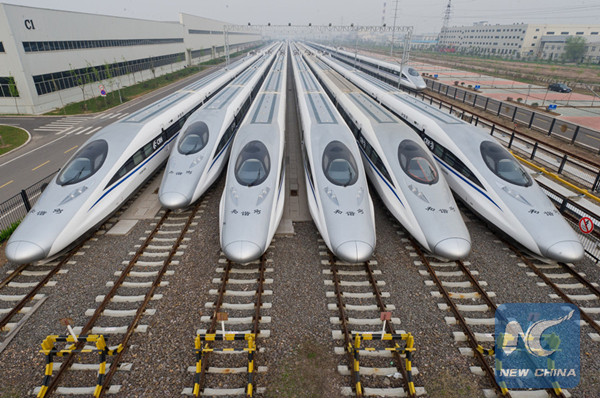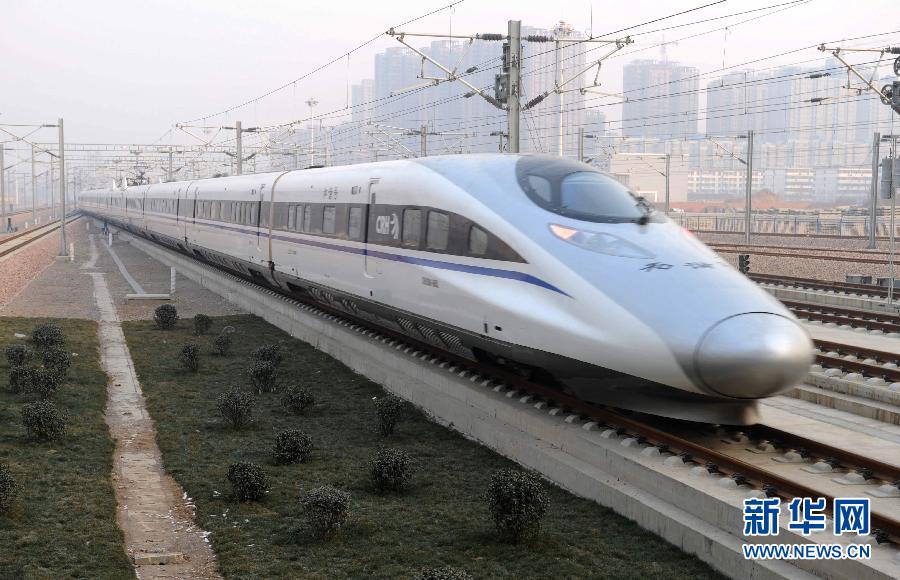JSCh
ELITE MEMBER

- Joined
- Jun 9, 2011
- Messages
- 13,235
- Reaction score
- 2
- Country
- Location
Spotlight: China's top train maker brings expertise, boosts industrial development in Malaysia
Source: Xinhua | 2016-08-17 09:55:09 | Editor: huaxia
by Lin Hao, Liu Tong
BATU GAJAH, Malaysia, Aug. 17 (Xinhua) -- Having built its regional manufacturing center in Malaysia, the China Railway Rolling Stock Corporation (CRRC) is also planning to expand its operations at the facility with an eye to exploring the ASEAN market.
More significantly, the Chinese top train maker hopes to benefit Malaysia by bringing expertise and creating opportunities for the local industries.
Located in the town of Batu Gajah, some 200 km from the capital of Kuala Lumpur, the CRRC Rolling Stock Center was designated as the company's manufacturing hub in Southeast Asia.
The ground-breaking ceremony of the 50-acre complex in 2013 was attended by Malaysian Prime Minister Najib Razak. The facility was put into trial run in early 2015 before full operation kicked in last October, according to Li Hong, general manager of the rolling stock center.
The first products built in the rolling stock center, six trains for Malaysia's Electric Train Service (ETS), are already operational. The center is now working on the second order of 15 trains for Ampang Line of the light rapid transit (LRT) network in Kuala Lumpur area, expected to be manufactured by the year-end.
"We now have a stable capacity to manufacture up to 200 carriages per year. We are also building facility for car overhaul service of 150 cars per year," Li told Xinhua.
He said future operations of the rolling stock center would focus on three areas: manufacturing, overhaul as well as service and maintenance.
"On manufacturing, we have the capacity to build trains for major railway, intercity line and urban mass transit; we could build subway cars, LRT cars, as well as for high-speed rail, electric locomotive or even magnetic levitation cars; we could build cars both for meter gauge and standard gauge," he said.
"On overhaul, we are building our facility and operation is expected to start by the year-end or early next year."
The Malaysian government is working on several plans to expand and renovate its railway network, on top of which is the cross-border high-speed railway linking Kuala Lumpur and Singapore.
With an estimated cost of over 10 billion U.S. dollars, the project has attracted interest from all major players in the high-speed rail, including China.
"We have taken account the prospect of building high-speed trains in this facility when planning," Li said, "The workshop and the equipment are all capable for high-speed trains."
LOCALIZATION A PRIORITY
Apart from its operation plans, the company has attached great importance to localization in a bid to benefit the locals and the industries.
While training the local employee for their work, the company has adjusted its management system that laid emphasis on incentive to adapt to the local culture. Their effort has already bear fruits.
"More than 80 percent of its total staff and more than 90 percent of the technicians at the production line are locally recruited, as well as two of its four department chiefs," said Li.
"We also have our eyes on the future, we have sent some of the staff to China for studies, fully funded by the company. We hoped that they could strengthen our management team in the future."
For procurement, the rolling stock center has set up an office dedicated to finding, cultivating and supporting local suppliers. According to the company, it now has some 300 local suppliers, ranging from equipment to transportation.
"The purpose of the manufacturing facility here is not simply sending in Chinese technicians to do the manufacturing and producing. We want to help boost local economic development and train local experts in railway transportation," said Li.
Source: Xinhua | 2016-08-17 09:55:09 | Editor: huaxia
by Lin Hao, Liu Tong
BATU GAJAH, Malaysia, Aug. 17 (Xinhua) -- Having built its regional manufacturing center in Malaysia, the China Railway Rolling Stock Corporation (CRRC) is also planning to expand its operations at the facility with an eye to exploring the ASEAN market.
More significantly, the Chinese top train maker hopes to benefit Malaysia by bringing expertise and creating opportunities for the local industries.
Located in the town of Batu Gajah, some 200 km from the capital of Kuala Lumpur, the CRRC Rolling Stock Center was designated as the company's manufacturing hub in Southeast Asia.
The ground-breaking ceremony of the 50-acre complex in 2013 was attended by Malaysian Prime Minister Najib Razak. The facility was put into trial run in early 2015 before full operation kicked in last October, according to Li Hong, general manager of the rolling stock center.
The first products built in the rolling stock center, six trains for Malaysia's Electric Train Service (ETS), are already operational. The center is now working on the second order of 15 trains for Ampang Line of the light rapid transit (LRT) network in Kuala Lumpur area, expected to be manufactured by the year-end.
"We now have a stable capacity to manufacture up to 200 carriages per year. We are also building facility for car overhaul service of 150 cars per year," Li told Xinhua.
He said future operations of the rolling stock center would focus on three areas: manufacturing, overhaul as well as service and maintenance.
"On manufacturing, we have the capacity to build trains for major railway, intercity line and urban mass transit; we could build subway cars, LRT cars, as well as for high-speed rail, electric locomotive or even magnetic levitation cars; we could build cars both for meter gauge and standard gauge," he said.
"On overhaul, we are building our facility and operation is expected to start by the year-end or early next year."
The Malaysian government is working on several plans to expand and renovate its railway network, on top of which is the cross-border high-speed railway linking Kuala Lumpur and Singapore.
With an estimated cost of over 10 billion U.S. dollars, the project has attracted interest from all major players in the high-speed rail, including China.
"We have taken account the prospect of building high-speed trains in this facility when planning," Li said, "The workshop and the equipment are all capable for high-speed trains."
LOCALIZATION A PRIORITY
Apart from its operation plans, the company has attached great importance to localization in a bid to benefit the locals and the industries.
While training the local employee for their work, the company has adjusted its management system that laid emphasis on incentive to adapt to the local culture. Their effort has already bear fruits.
"More than 80 percent of its total staff and more than 90 percent of the technicians at the production line are locally recruited, as well as two of its four department chiefs," said Li.
"We also have our eyes on the future, we have sent some of the staff to China for studies, fully funded by the company. We hoped that they could strengthen our management team in the future."
For procurement, the rolling stock center has set up an office dedicated to finding, cultivating and supporting local suppliers. According to the company, it now has some 300 local suppliers, ranging from equipment to transportation.
"The purpose of the manufacturing facility here is not simply sending in Chinese technicians to do the manufacturing and producing. We want to help boost local economic development and train local experts in railway transportation," said Li.







